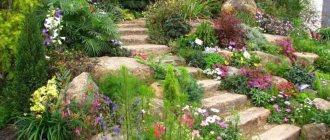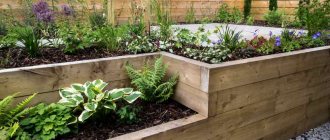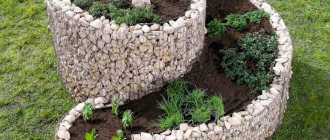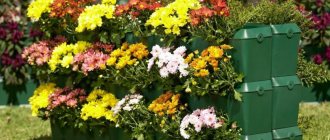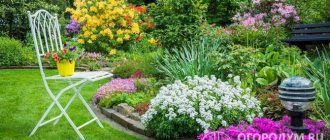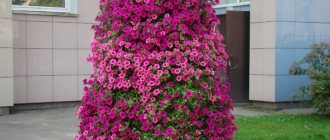Creating a beautiful flower bed is a real art; here you need to take into account a lot - types of plants, their compatibility, planting features. But an important role in creating a truly interesting and luxurious flower bed is played by the scheme according to which the flowers are planted. The bright colors of the flowers, their height, and arrangement in a certain order form beautiful patterns, making the flower bed a carpet of fresh flowers. Creating a flowerbed using a complex design and a large number of plants is not easy, but there are flowerbed designs for beginners where you can use a few plants and a fairly simple design - and you will certainly be pleased with the result.
The traditional approach to designing a flower bed is to plant flowers in accordance with a pattern, but often plants are planted in random groups. Regardless of which approach you choose, we invite you to familiarize yourself with the basic principles of flower bed design in the following video:
Creating a flowerbed yourself is not so difficult - you need to choose a suitable place, select flowers and decide on the scheme for planting them. If you want to plant plants in such a way that they form a certain pattern, you need to draw a diagram on a piece of paper, and then transfer the markings to the flowerbed.
The simplest option is a round flower bed. You can decorate it as follows - plant a group of tall flowers, for example, delphinium, in the center, plant plants of the same type along the edges as a frame - balsam, flax or pansies (for example), and fill the distance between the center and the edge with flowers that all bloom summer, it can be petunia, pelargonium, marigolds, nasturtium, begonia semperflorens.
The drawing will help in many ways in creating a flower bed - you will clearly see how best to arrange the flowers, the color scheme will give a visual idea of the appearance of the flower bed
A spectacular flower bed created according to a simple design. The graceful curl resembles a question mark, but it can also be a circle. Two types of plants in contrasting colors, in the center there is a raised flower bed, but it is not necessary to create one, you can leave the center green or plant tall plants in it
When you create a design, you need to think about the colors and shades you want to see in your flower garden. Color combinations in a flower bed can be very diverse.
What is a flowerbed of continuous flowering?
- A flower bed of continuous flowering is usually called a flower garden for which plants are selected according to several parameters at once: height, color, leaf shape, growth rate, etc.
- In this case, the main indicator for selection is the flowering time of the plant: it is important that flowering specimens are constantly present in the flowerbed. Those that have already bloomed, as well as those that are still in the growth period, act as a background component.
- A flowerbed of continuous flowering can also rightfully be defined as a mixborder . The word “mix” itself suggests that mixing is taking place: colors and shades, tall and short, perennials and annuals. And if you use evergreen and coniferous plantings in the design of such a flower bed, it will please the eye even in winter.
Constant flowering
Selection of types of flowers
Creating a beautiful flower bed is a creative process that can completely absorb any gardener. This is a great way to realize your potential as a creator. By choosing the right plants for your flower beds, you can create a real living work of art on your site.
Making a flower garden from annuals
Scheme of a triangular flower bed
A huge number of seeds of all kinds of flowering plants are now sold on store shelves. Which ones are best suited for creating flower beds? First of all, focus on the growth and flowering period of plants, as well as the color of their petals.
Table. The most popular types of flower plants for flower beds .
| Name | Flowering period | Height, cm |
| Lobelia | June-September | About 15 |
| Ageratum | July-October | 15-70 |
| Iberis | June-October | Up to 40 |
| Marigold | June-September | 15-100 |
| Nasturtium | June-October | Creeping up to 400, bush 50 |
| Petunia | June-mid October | 15-80 |
| Zinnia | June-October | 20-70 |
Also, low-growing annuals include: dwarf begonia, viola, lobularia, dwarf aster; for tall ones: lupine, peony, astilbe.
raised flower bed
Prices for annual seeds
annual seeds
What are the basic rules for forming a flowerbed of continuous flowering?
- The first and most necessary rule is that the size of a continuous flowering bed must be large , since in order for it to be a blooming oasis for a long time, it is necessary to plant many types of flowers.
- The second rule is the predominant use of perennial specimens; they are easier to care for and bloom regardless of when they are sown and when the seedlings are planted in the flowerbed.
- The third point is the choice of unpretentious flowers . This is due to the fact that each plant has its own requirements regarding soil, frequency and abundance of watering, lighting and other factors. Having planted rather capricious plants nearby, it will be difficult to achieve comfort for each of them.
- The fourth rule is to stick to a natural style with a loose fit . It is better to plant flowers not individually, but in groups, otherwise you will end up with a motley mishmash in which it will be difficult to consider each species. An exception may be large bush specimens, for example, tree peony.
- Fifth rule: choose plants for planting in the flowerbed whose foliage does not dry out or become wilted after the color ends . This will provide a bright green background for a long time, otherwise your flowerbed will look sloppy. An excellent example are the Arabis flowers, which, having stopped blooming as early as May, can remain a variegated green and white border until the autumn days.
- And finally, the sixth rule: annually “put things in order” in a flowerbed of continuous flowering, removing specimens that have already lost their decorative effect, replacing them with new ones.
Bright bloom
Rules for the location of beds
To get the maximum harvest, you need to properly arrange your garden at your dacha, and for this you must adhere to the following rules:
- choose the sunniest place - all vegetable crops love warmth and the rays of daylight;
- Before sowing or planting, the soil should be leveled;
- if the soil has a slope, then plants should be planted across it (slope), thereby increasing the efficiency of irrigation;
- try to keep the beds the same length (three to four meters) and width (up to 45 centimeters).
Important! Symmetry always improves visual perception and allows for free access to the cultivated area. Do not arrange beds between fruit trees under any circumstances - the shade will not allow you to get a good harvest, and besides, the chemicals that are used to treat the fruit trees may get into the vegetables!
How to create a flower bed with perennial flowers that bloom continuously?
- It is necessary to carry out work on planting perennial plants, creating a flowerbed of continuous flowering, in the fall - this way the plants will take root and bloom within a few months, with the onset of spring. At the same time, bulbous plants are also planted that overwinter in the ground, for example, daffodils with crocuses, tulips with galanthus, hyacinths and scylla.
- If you are already growing perennials, then you have decided how adaptable they are to the conditions and the sequence of their flowering. This way you can form the basis of an ever-blooming flowerbed, and if your flower beds have moments when flowering is not observed, purchase flowers that bloom during these periods so that they fill these “gaps”.
- identical specimens with early and late flowering periods in such an ever-blooming flowerbed , especially if you like this or that flower - this way you will prolong the pleasure of admiring them. For example, from the beginning of May your eye will be pleased with dwarf varieties of irises, and at the beginning of summer - tall beauties.
- You can also supplement a continuous flowering bed with annuals that have a long flowering period: salvias, verbena, marigolds, petunias , etc. They will perform two functions at once: they will become a wonderful bright accent until the perennial plants bloom, and they will “cover” those places where the plants have been damaged by pests or an unsuccessful wintering.
For permanent beauty in the flowerbed
Aesthetics
As the great Faina Ravnevskaya said, “Beauty is a terrible power!” It's hard to disagree with this. We must try to “kill two birds with one stone” - get healthy and necessary products, and please the eye with the beautiful design of the site.
The right design style will help you achieve such harmony: minimalist or French.
Let's talk about the features of these stylistic trends in more detail.
How to choose a color scheme for a flower bed of continuous flowering perennials?
- This is quite a difficult task, because changes in the color scheme of an ever-blooming flowerbed occur more than once during the season. In spring, when primroses bloom, shades and colors change quickly, just as the first spring flowers fade. A combination of white and blue would be appropriate here; when crocuses and snowdrops , they are replaced by daffodils and primroses, which paint the flowerbed with all the colors of the rainbow. Then comes the turn of tulips, which also have a wide variety of colors, and will be complemented by white arabis, yellow doronicum and blue-blue shades of forget-me-nots and muscari .
- The same bright palette is represented by irises , the most popular colors of which are lilac, blue, and yellow-brown. Then peonies bloom along with daylilies and delphinium. They will be perfectly shaded by perennial carnations that have a small height. The phloxes and astilbes that will replace them can be selected not only depending on the shade, but also taking into account their height and flowering time, complementing them with pink echinacea or white nevus.
- As for roses , their flowering time is from the first days of summer until the onset of autumn cold weather. Their colors and varieties are so diverse that, by selecting specimens that bloom early, you can arrange a flowerbed of continuous flowering from only roses.
- Autumn flowering is the time of chrysanthemums, dahlias, marigolds, calendula, salvia . Most often they create a yellow-red color scheme. And, of course, while waiting for the growth of perennial plants, it would not hurt to supplement the flowerbed with annuals, for example, petunias, which can delight the eye with their color throughout the summer.
Which plants to choose
In the process of creating flower beds that organically fit into the overall style of the landscape, it is necessary to be guided by several principles.
Rules for arranging flower beds
- Plants are selected in a contrasting or harmonious combination of similar colors, taking into account not only the color of the petals, but also the shape and size of the plant.
- It is not recommended to create excessive spice. Usually no more than four varieties are placed in one flowerbed.
- The height of the selected flower crops is taken into account, placing low-growing varieties at the forefront.
- The highest aerobatics of landscape art is considered to be the provision of a continuous change in the color background, thanks to the planting of varieties with different periods of bud formation.
- Giving preference to perennials, they turn to zoned varieties that can withstand the winter seasons without damage.
Plants such as clematis and peonies can grow without replanting for several decades, delighting with abundant flowering.
On a note! The advantages of perennial flowers also include easy care and low financial costs, since there is no need to purchase new seedlings every year.
Among modern trends, several color options for flower beds attract attention:
- Monochrome. Involves the selection of shades of different saturations of the same color. This group also includes plants with decorative foliage, the variety of which varies from silver-green, ant, malachite, lemon to pearl tones.
- Green and white combinations. To create such a fresh sound, primrose, peonies with white inflorescences, and hydrangea are planted. Mock orange and spirea add charm to the site.
- Green-pink version. Chrysanthemums, clematis, charming roses, and astilbe create unusually delicate and imaginative tints in this range. You can plant decorative barberry and bergenia.
- Monoformality. It involves placing varieties that have a single shape in one flower bed. An interesting option is the round crown. For example, blue fescue, standard roses, and large-leaved hydrangea are planted. The spherical thuja adds charm and amazing grace.
- Contrast. To solve such a problem, which involves an unusual, very bright sound, flowers are planted that have, for example, yellow and purple colors. Burgundy and blue buds create a striking contrast.
A fashionable option remains the blue-yellow combination, for which irises of different varieties, viola, delphinium, and daylily are suitable.
How to choose flowers for a flower bed of continuous flowering perennials?
When selecting plants, it is important to consider several parameters:
- Flowering time;
- Coloring of specimens;
- Flower height;
- Similar growing conditions.
Lush flowering in a flowerbed
- If everything is clear enough with the first three points - select flowers for a flowerbed of continuous flowering so that some fade while others bloom at this time, plant them so that low-growing specimens are not covered by tall plants, and according to the color scheme - it all depends depending on your preferences, then the conditions of detention and compatibility should be discussed separately.
- Flowers need to be selected so that they all feel good in similar conditions. That is, they should have approximately similar requirements regarding the frequency of watering, soil composition and moisture content, as well as illumination. For example, if you plant snowdrops or hosta , which prefer shade, and verbena and poppy, which need as much sun as possible, then some specimens will be uncomfortable. Irises that require frequent watering and echinacea that does not like excessive moisture are also unlikely to get along in the same conditions. And on poor soils oregano will grow, but rhododendron will disappear.
- In addition, keep in mind that lilies of the valley , for example, due to their fast-growing root system, can grow throughout the entire flowerbed, and the bluebell is characterized by self-seeding, which can also lead to its growth in those places that you planned for completely different flowers. The sunflower depletes the soil, taking nutrients from it, which is destructive for its neighbors.
Great design
Organization of watering
In addition to soil composition and good lighting, vegetable crops need moisture. Depending on the region where the summer cottage is located, care must be taken to properly organize the irrigation of the garden.
There must be a water reserve on the site - a water supply system, a well, barrels of water.
You can choose the watering method according to your taste - using a hose or a drip irrigation system.
Important! The presence of groundwater near the surface (a little more than half a meter) will require the design of a drainage system to remove excess moisture.
When and how to plant flowers for a flower bed of continuous flowering perennials?
- Perennials are best planted in early autumn so that they can establish, overwinter and begin flowering in the spring. The same is done with bulbous plants.
- And so that the continuous flowering bed is not empty before they begin to bloom, you can plant seedlings of annuals as early as February and when the heat becomes stable, transplant them to the flowerbed, where they will create bright spots of color. If you plant them directly in the soil in warm spring, they will begin to bloom later.
- When planting perennials, give them up to half a meter of space so they can grow. The same should be done with annuals. It doesn’t hurt to make a kind of “stock” of annual plants in a separate place: if you see that a void is forming somewhere, you can fill it with these specimens.
- It is better to start planting annuals from the central part of the flowerbed, and if you are not planting in a circle, then at the back.
Monoclumba - stylish and simple
Traditional lawns can easily be enlivened with a monoflower - a small flower meadow on a green, clipped carpet. In the center of the lawn, the soil is removed along with the grass, the area is fenced off with a flexible border, and the interior space is filled with fertile soil mixture.
In the resulting “window” any flowers suitable for the country landscape are planted.
If bulbous plants (tulips, daffodils) are used, after they have finished flowering, bright annuals can be planted in the monoflower bed: petunia, viola, tagetes, zinnia, celosia and others.
Majestic roses and graceful cannas look very beautiful on the green lawn.
Plants with variegated (variegated) foliage will help create an unusual composition, for example, creeping species of euonymus fortunena, variegated brunnera, some types of hosta, ivy-leaved budra.
At your dacha you can create just one small flower bed or several types of flower beds. In any case, they will decorate the area, uplifting the mood and conducive to relaxation.
How to care for a flower bed of continuous flowering perennials?
- Flowers need feeding. Since there are many types of them, it is better to use universal formulations, which are applied in small quantities 3-4 times during the warm season.
- When the flower has faded, remove it immediately, as self-seeding is possible, which will ruin your flowerbed next season. In addition, wilted flowers, like leaves, will make a flower bed of continuous flowering unsightly and untidy. At the same time, if withered leaves are practically not visible due to the flowers growing in front, you don’t have to cut them off - the appearance of the flower garden will not be affected, and the soil will receive additional organic fertilizer.
- Pay special attention to bulbous plants. They usually overwinter well in the ground without the need for digging. The exception is particularly sensitive varieties that are not adapted to frost, which are better to dig up.
- Also, at the end of flowering, when the stem dries, you can dig up those plants that have grown too much. The bulbs should be carefully separated from each other, dried and stored until the autumn, when they can be planted in open ground.
Let's sum it up
Each of the flower beds discussed in the article deserves attention. Each of them has its own characteristic features.
Mixborder looks more natural, closer to natural nature, and therefore induces calm and tranquility.
On the contrary, rabatka is more impressive, looks bright and festive, and creates an uplifting mood.
The Alpine slide creates an unusual flavor characteristic of the mountainous Alpine landscape. This gives originality to the site.
Choose what best suits your inner world.
But in any case, I hope that now it will be easier for you to answer the question of how to plant beautiful flowers in your dacha.
In conclusion, I must tell you to keep in mind that some flowers do not get along well with each other. This must be taken into account when placing them in the flower garden.
For example, tulips and lilies, roses and peonies are not the best neighbors; bulbous plants do not coexist well with buttercups. Dahlias do not have the best effect on nearby neighbors.
In general, working with flowers is always creativity, and a very pleasant one at that. Especially if there is a good result.
Best regards, Alexander Tkachenko.
How to make a diagram of a flower bed of continuous flowering perennials: examples
- A previously drawn up schematic picture of a future flowerbed of continuous flowering will help you better imagine what the combination of colors will look like , how many plant specimens will be needed, and which ones exactly. You can sketch out several diagrams to clearly see the advantages of a particular option and its applicability in the conditions of the area you have allocated for planting.
- The diagram can be drawn on a large sheet of paper, divided into cells, taking a scale for each cell: depending on the total area of your flower garden, you can consider one cell as a quarter or half a meter. Now fill the cells, looking for the optimal place for the plants that you plan to plant: this way you will clearly see who is next to whom, whether the flowers replace each other in terms of flowering time, whether they are combined in height and color scheme. In such a diagram, you can also provide for the diameter that a bush planting of a particular plant will reach in 3-4 years.
- The basic rules for filling a flower bed with perennials have already been described above. By adhering to them, you can create a flowerbed according to a pattern that will give you the opportunity to admire continuous flowering, starting from March-April and ending with the days of November.
Flowerbed diagram
Example 1:
A universal composition that combines specimens that bloom at different times. They are marked with the following positions:
- snow forsythia;
- lungwort;
- delphinium;
- herbaceous sunflower;
- miscanthus chinensis;
- Phlox paniculata;
- daffodils;
- helenium;
- hellebore;
- astrantia;
- coreopsis whorled;
- hare cabbage;
- geranium;
- aquilegia;
- catnip;
- sage;
- cushion aster;
- bellflower peach;
- portable flowerpot with seasonal plants;
- geranium;
- The cuff is soft.
Result
Scheme
Example 2:
Another option for a flower bed of perennial plants, which can be laid out both in the shade and in a well-lit place. This flowerbed is designed according to the principle of a year-round combination of yellow, red and blue-blue shades:
- stock-rose (can be any shade);
- ten-petalled sunflower;
- Iceland poppy;
- St. John's wort, odorless;
- cardinal's lobelia;
- Fassin's catnip;
- Poskharsky's bell;
- catananche blue;
- Gravilat Chilean Feuerball;
- sedum Matrona;
- Heuchera blood red.
Scheme
Example 3:
This diagram shows an autumn flower garden, in which there are:
- Thuja occidentalis "Yellow Ribbon";
- Three types of Echinacea: “Mama mia”, “Marmalade” and “Tangerine Dream”;
- Spiraea japonica "Golden Carpet";
- Penisetum foxtail "Little Bunny";
- Sedum “Black Beauty” (our better known name is sedum);
- Juniper "Lime Glow";
- Pennisetum bristly "Rubrum";
- Switchgrass "Rotstrahlbusch".
Combination
Example 4:
And here is an example of a diagram of a flowerbed of continuous flowering in the spring-summer period, following all the rules for placement according to plant height:
- geranium macrorhizomatous;
- sedum;
- Siberian iris;
- golden yarrow;
- peony bush "Rubra Plena";
- switchgrass bush “Heavy Metal”;
- common mordovnik bush.
Constant flowering
Example 5:
And here is an original decorative solution: the color scheme of the planted plants creates the illusion of a flowing stream:
- bamboo leaf (you can choose ostrich as a replacement option);
- irises;
- lobelia;
- creeping tenacious;
- Poskharsky's bell;
- aubrieta hybrids;
- Brunnera macrofolia;
- awl-leaved bryozoan;
- red creeping tenacious;
- and again, bamboo or ostrich, they will “close” the composition into a single whole.
Like a stream
Option 3. Flower bed along a fence or wall
When decorating a flower bed along a fence or wall, you should also follow the rules for planting plants in the form of a “ladder”. Therefore, low-growing shrubs or flowers are planted in the foreground.
In the diagram presented above, Japanese spirea and ground cover roses are placed closer to the edge of the flower bed. It is no coincidence that juniper is planted between them; it serves as a kind of dividing layer between two shrubs blooming at the same time.
To give the flower garden a more solemn appearance and create a symmetry effect, tall plants with a pyramidal crown are planted along the fence. The basis of this composition is made up of paniculata hydrangea bushes, located in the center. The white summer flowering of hydrangea is supported by pale pink candle-shaped inflorescences of Douglas spirea; the symmetry is emphasized by pyramidal thujas beautifully standing on both sides of the flower garden. Delphinium sets the color in the autumn period and with its height enhances the effect of “striving upward”.
Flowerbed of continuous flowering perennials: tips
- To select plants that will feel comfortable in the climatic conditions of your region, pay attention to what flowers, shrubs, and herbs are planted in flower beds in parks and squares in your locality. This selection was made by professional landscapers, taking into account the requirements of the plants.
- If you like the color scheme, you can duplicate it. For example, you planted hellebore, whose snow-white flowers look great next to blue crocuses. Feel free to plant anemones and muscari nearby, which will bloom later, while maintaining the combination of white and blue.
- Plants with variegated leaves will look beautiful either in a group or as a border. The same unpretentious coleus will save you from worries about care and will delight you with an elegant look all season long.
- The continuity of flowering of your flower bed can be ensured even in winter. To do this, you can supplement the flower garden with coniferous specimens, which will make the area green and elegant even in the winter months.
Useful articles on the site:
- Perennial dahlia flowers - planting tubers, growing
- Do-it-yourself flower beds and flower beds using improvised materials
- How to properly feed house plants
- The best perennial flowers for your garden
- Blue flowers for the garden
Basic principles of creating a flower garden
When designing a picturesque flowerbed, you should focus on a number of rules for its rational design and understand the terminology. There are mainly two groups:
- Flower beds that have a regular shape with strict geometric parameters;
- Varieties of flower beds of any, sometimes the most unexpected configuration.
Peculiarities
A bright, dense flower bed will only be possible in a lighted area. To correctly create a composition, you need to select plants in advance and imagine the appearance of each specimen at different times of the year. Transforming a garden is a labor-intensive process that requires constant presence in the garden beds. Before you start working with soil, you should consider the following nuances:
- Soil features. Each flower has its own type of soil;
- Climate. Emphasis should be placed on pure varieties and hybrids that take root well in the planting region;
- Terrain. You can make a beautiful flower bed on a flat surface, on a slope, or in a lowland. A certain type of plant is suitable for each option;
- Illumination. Not all colors are suitable for a sunny area. Species that love partial shade are best planted in a flowerbed near the fence, next to tall bushes;
- Planting density. It is necessary to maintain a certain distance for each plant in the circle of neighboring flowers;
- Flowering dates. In order for the flowerbed to delight with color throughout the summer season, varieties should be selected with different flowering periods and durations.
